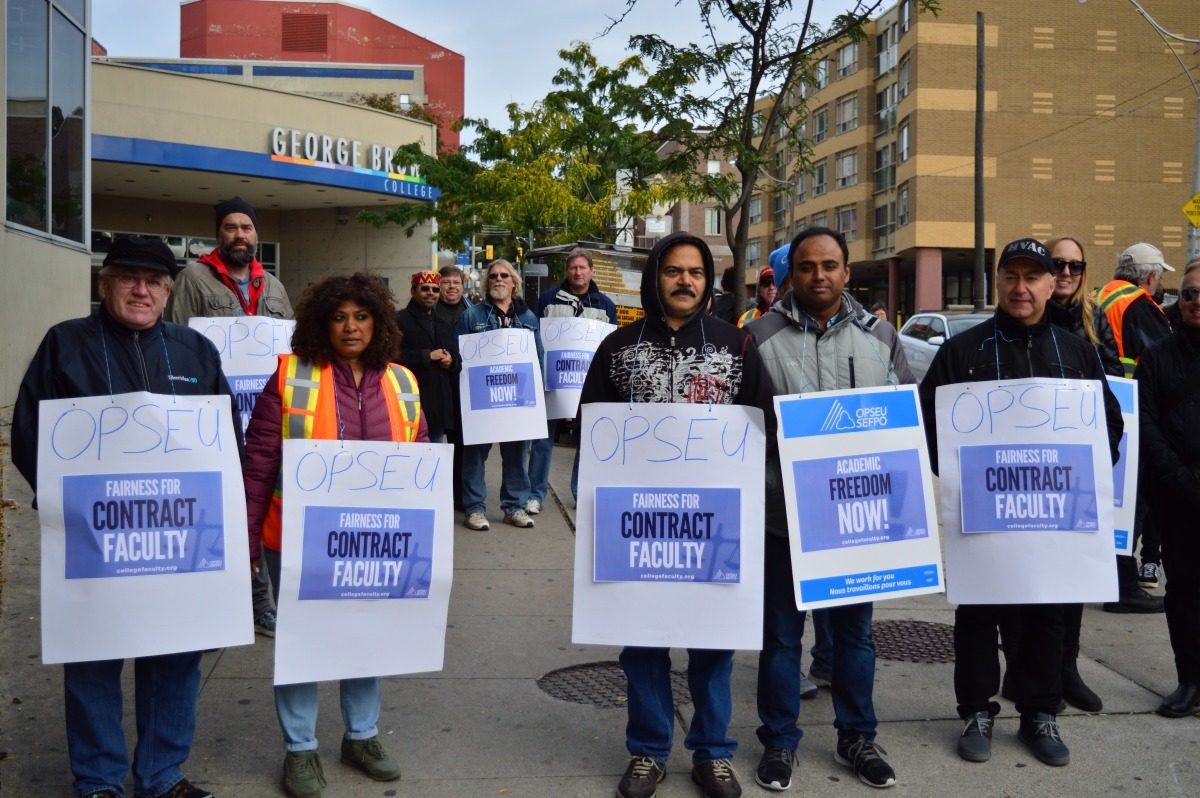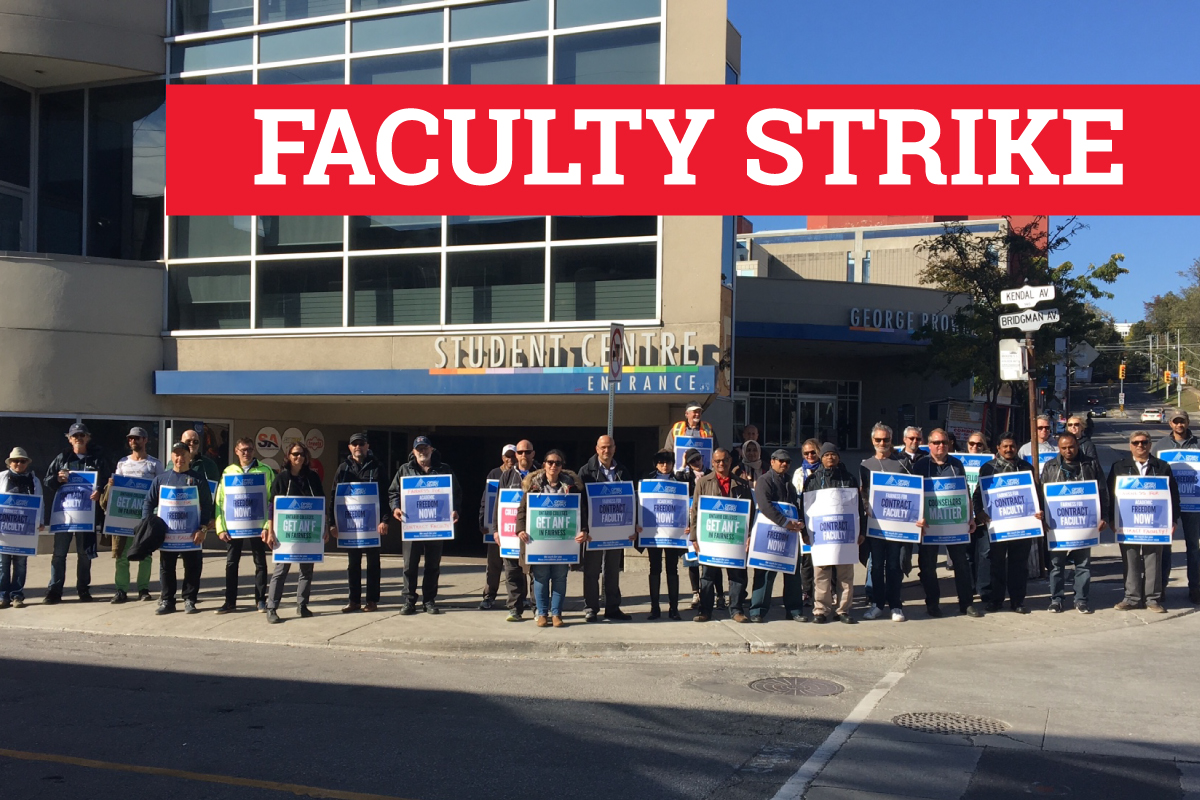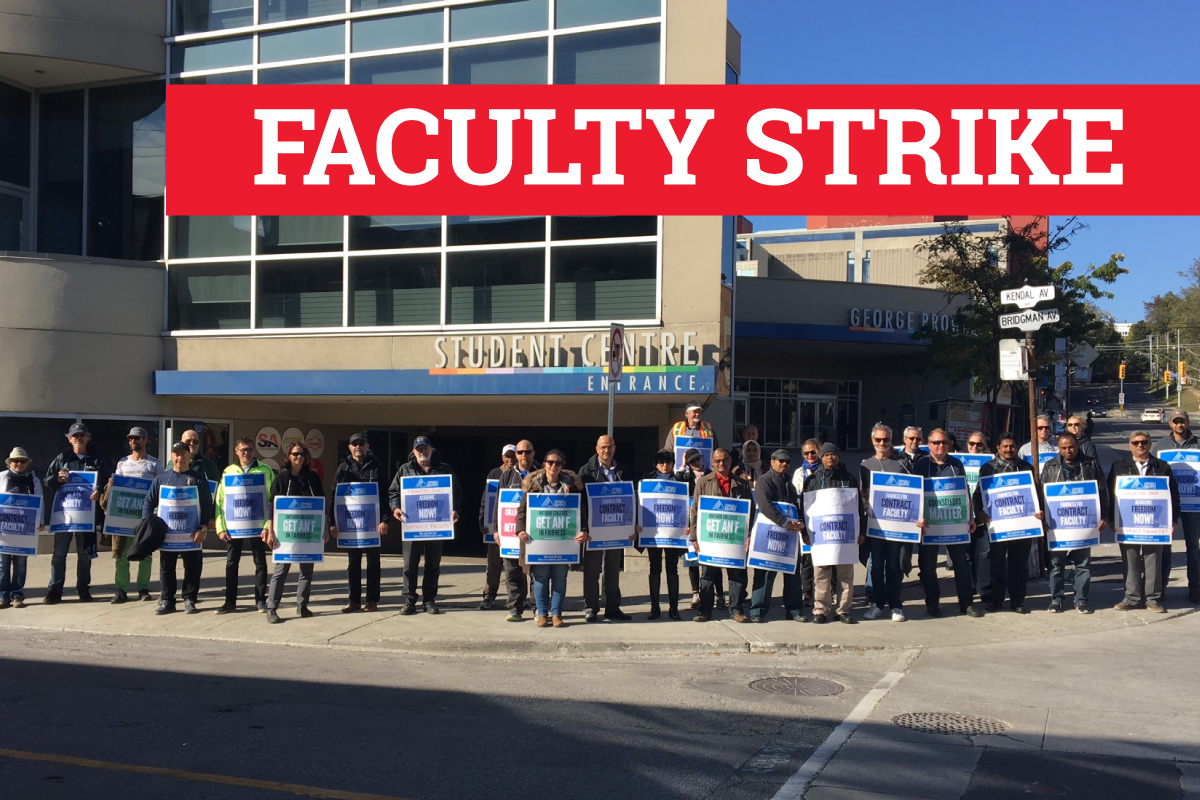Ontario Colleges Faculty Strike: The recent walkout by Ontario college faculty sent shockwaves through the province, disrupting student learning and sparking intense debate. This wasn’t just a labor dispute; it highlighted deep-seated concerns about working conditions, student support, and the future of post-secondary education in Ontario. We’ll explore the key issues, the impact on students, and the potential long-term consequences of this significant event.
From the faculty’s demands for better compensation and improved working conditions to the colleges’ counter-arguments and the role of the provincial government, this strike touched upon numerous facets of the educational landscape. Understanding the complexities of this situation requires examining the various perspectives, from students struggling with interrupted studies to faculty members fighting for fair treatment. We’ll analyze the media coverage, public opinion, and the potential long-term effects on Ontario’s college system.
The Impact of the Ontario College Faculty Strike on Students
The Ontario college faculty strike significantly disrupted student life, impacting academic progress, support services, and mental well-being. The length and intensity of the strike varied across programs and campuses, leading to diverse student experiences.
Disruption to Student Learning
The strike resulted in cancelled classes, postponed exams, and disrupted lab sessions. Many students experienced delays in completing coursework and accessing crucial learning resources. The uncertainty surrounding the strike’s duration added significant stress and impacted students’ ability to plan their academic schedules effectively. Some students reported difficulty in maintaining momentum in their studies, leading to feelings of frustration and academic setbacks.
Affected Support Services and Their Impact
The strike also impacted various student support services. Counselling services, academic advising, and career services were often reduced or unavailable during the strike, leaving students without vital resources during a period of high stress. This lack of access exacerbated anxieties related to academic progress, career prospects, and overall well-being. The disruption to library access also hampered research and study efforts for many students.
Impact on Student Mental Health and Well-being
The prolonged uncertainty and disruption caused by the strike significantly impacted students’ mental health and well-being. Many students reported increased stress, anxiety, and feelings of isolation. The lack of access to support services further compounded these challenges. The financial implications of the strike, such as lost income from part-time jobs or delayed graduation, added to the existing stress. Some students expressed feelings of anger, frustration, and disappointment with the lack of progress in negotiations.
Comparative Experiences Across Programs
| Program | Impact on Learning | Impact on Support Services | Mental Health Impact |
|---|---|---|---|
| Nursing | Significant disruption to clinical placements and lab work | Limited access to academic advising and career services | High levels of stress and anxiety due to clinical placement delays |
| Engineering Technology | Delayed access to specialized equipment and labs | Reduced access to technical support | Moderate stress due to project deadlines and academic uncertainty |
| Business Administration | Mostly impacted by cancelled lectures and seminars | Minimal disruption to support services | Lower levels of stress compared to programs with significant practical components |
| Humanities | Primarily impacted by cancelled lectures and seminars | Minimal disruption to support services | Moderate stress due to academic uncertainty and project deadlines |
Faculty Demands and Negotiating Positions
The Ontario college faculty strike stemmed from a complex interplay of demands, counter-proposals, and differing positions between the faculty and the colleges. The provincial government also played a significant role in the negotiations.
Key Demands of the Ontario College Faculty

The faculty’s key demands generally centered around improved job security, better compensation, and increased support for part-time faculty. Specific demands often included increased wages to reflect the rising cost of living, improved benefits packages, and measures to reduce the reliance on precarious part-time contracts. Concerns about workload and equitable treatment were also prominent in the faculty’s demands.
College Counter-Proposals, Ontario colleges faculty strike
The colleges’ counter-proposals generally offered less substantial increases in compensation and benefits than the faculty demanded. Proposals regarding job security and part-time faculty often fell short of the faculty’s expectations. The colleges emphasized the financial constraints they faced and argued that the faculty’s demands were unsustainable.
Comparison of Positions
The core difference between the faculty and the colleges lay in the perceived value of the faculty’s work and the colleges’ capacity to meet their demands. The faculty argued for fair compensation and improved working conditions reflecting their expertise and contributions. The colleges, citing budgetary limitations, prioritized fiscal responsibility and maintained that their counter-proposals were fair and reasonable.
Role of the Provincial Government
The provincial government played a crucial role by setting the overall framework for the negotiations and potentially mediating disputes. Their involvement influenced the bargaining power of both sides and shaped the eventual outcome of the strike. The government’s stance on funding for colleges and its priorities regarding post-secondary education significantly affected the negotiations.
Public Opinion and Media Coverage: Ontario Colleges Faculty Strike
Public perception of the strike and its causes varied significantly, shaped by media coverage and the messaging from both sides. Different media outlets presented varying perspectives, impacting public understanding of the issues at stake.
Public Perception of the Strike
Public opinion was largely divided, with some supporting the faculty’s demands for improved working conditions and compensation, while others criticized the disruption to students’ education and the potential economic impact of the strike. Public sympathy often shifted depending on the media narrative and the framing of the issues.
Media Portrayal of the Strike

Different media outlets presented varying perspectives on the strike. Some emphasized the disruption to students’ education, highlighting the negative impact on their academic progress and well-being. Others focused on the faculty’s demands, portraying them as justified given the increasing cost of living and the precarious nature of many faculty positions. The tone and emphasis of media coverage significantly influenced public perception.
Key Talking Points
The faculty’s key talking points often centered around fair compensation, job security, and the need to improve the quality of education. The colleges, on the other hand, emphasized the financial constraints they faced, the impact of the strike on students, and the reasonableness of their counter-proposals. Both sides used these talking points to shape public opinion and gain support for their positions.
Timeline of Significant Events
A timeline of significant events would include the initial breakdown of negotiations, the commencement of the strike, key media events (e.g., press conferences, interviews), significant developments in negotiations, and the eventual resolution of the strike. This timeline would offer a chronological overview of the key events and their impact on public perception.
Long-Term Consequences of the Strike
The Ontario college faculty strike had several potential long-term consequences impacting the reputation of Ontario colleges, student enrollment, and future labor negotiations in the post-secondary sector.
Impact on the Reputation of Ontario Colleges
The strike could potentially damage the reputation of Ontario colleges, particularly if the disruption to students’ education was perceived negatively. This damage could affect future student enrollment and the overall standing of the colleges in the broader educational landscape. The handling of the strike by the colleges and the provincial government also played a role in shaping public perception and long-term reputation.
The Ontario colleges faculty strike is causing major disruptions for students, impacting their learning and future prospects. Keeping up with the latest developments is crucial, and you can find reliable news and updates on various tech platforms, including the innovative developments showcased at news technology events like DroneFair. Understanding how technology impacts education during this strike is also important, as it could play a role in finding solutions and alternative learning methods.
Impact on Student Enrollment
The strike could lead to decreased student enrollment in future years. Students may choose to attend other institutions or delay their education due to the disruption and uncertainty caused by the strike. This decrease in enrollment could have significant financial implications for the colleges.
Okay, so the Ontario colleges faculty strike is causing a huge disruption, right? It’s got everyone stressed, kind of like watching a wildfire spread – except instead of flames, it’s worried students. You know, it makes you think about the amazing work of those who fight actual fires, like the crews using the incredible canadian super scooper plane.
Hopefully, a resolution to the strike comes quickly, before things get completely out of hand.
Financial Implications
The strike resulted in financial losses for both the colleges and the faculty. Colleges faced lost tuition revenue and potential increases in operating costs. Faculty members experienced lost wages during the strike, impacting their personal finances and overall well-being. The long-term financial consequences could have lasting impacts on both parties.
Influence on Future Labor Negotiations
The outcome of the strike and the negotiating process will likely influence future labor negotiations in the post-secondary sector. The success or failure of the faculty’s demands could set a precedent for future negotiations and impact the bargaining power of faculty unions across the province. The resolution of the strike, including any concessions or compromises made by either side, will likely inform future labor relations in Ontario colleges.
Alternative Dispute Resolution Methods
Several alternative dispute resolution (ADR) methods could have been employed to resolve the Ontario college faculty strike, potentially avoiding the disruption to students and the financial losses incurred by both sides.
Alternative Dispute Resolution Methods
ADR methods such as mediation, arbitration, and conciliation could have been used to facilitate communication and find common ground between the faculty and the colleges. These methods provide a structured framework for negotiations, allowing both parties to express their concerns and explore potential solutions in a neutral environment. Early intervention with ADR could have prevented the escalation of the conflict and the subsequent strike.
Effectiveness of ADR Methods
The effectiveness of ADR methods depends on the willingness of both parties to engage in good-faith negotiations and compromise. In situations where both sides are entrenched in their positions, ADR may be less effective. However, when parties are open to finding mutually acceptable solutions, ADR can be a valuable tool for resolving disputes peacefully and efficiently. Success often relies on skilled mediators or arbitrators who can guide the parties towards a mutually beneficial outcome.
Examples of Successful Applications
Numerous examples of successful applications of ADR in resolving faculty strikes exist in other post-secondary institutions. These cases demonstrate the potential of ADR to prevent lengthy strikes and mitigate the negative consequences for students and the institution. Analyzing these successful cases can provide valuable insights into effective strategies for future negotiations.
The Ontario colleges faculty strike is really impacting students, leaving many wondering what the future holds. It’s a situation that feels a bit like a wildfire, needing a quick solution, almost like needing a fleet of super scoopers to put out a blaze. Hopefully, a resolution comes quickly so students can get back to their studies without further disruption.
Potential ADR Strategy for this Situation
A potential ADR strategy for this specific situation could have involved early mediation, focusing on identifying common ground and addressing the core concerns of both the faculty and the colleges. This approach could have involved a neutral third party who facilitated communication and helped the parties explore creative solutions to bridge the gap between their positions. A structured negotiation process, potentially combined with arbitration as a final resort, could have provided a framework for resolving the dispute without a prolonged strike.
Illustrative Examples of Student and Faculty Experiences
The following narratives offer a glimpse into the lived experiences of students and faculty during the Ontario college faculty strike, highlighting the challenges and impacts of the disruption.
Student Experience
Sarah, a second-year nursing student, described the strike as incredibly stressful. The cancellation of her clinical placements significantly hampered her progress towards graduation. She worried about falling behind her peers and felt anxious about the uncertainty surrounding her academic future. The lack of access to counselling services during the strike further compounded her stress and anxiety. She felt frustrated and helpless, unable to control the situation and worried about the potential impact on her career aspirations.
Faculty Member Experience

Professor David, a tenured professor in the engineering technology department, participated in the strike to advocate for better working conditions and improved job security for part-time faculty members. He felt that the colleges’ proposals were inadequate and did not address the core issues of precarious employment and workload imbalances. He believed that the strike was necessary to ensure that all faculty members, regardless of their employment status, received fair compensation and had reasonable working conditions.
He felt a strong sense of responsibility to his colleagues and a commitment to fighting for a more equitable system.
Hey, so the Ontario colleges faculty strike is really impacting students. It’s a tough situation, especially considering many rely on financial aid. This is further complicated by the upcoming changes, like the canada january 2025 OAS boost , which might not immediately alleviate financial pressures for those affected by the strike. Hopefully, a resolution to the strike comes quickly so students can get back to learning.
Specific Event or Incident
A particularly challenging incident occurred when a group of students organized a protest outside the college administration building. Frustrated by the lack of progress in negotiations and the continued disruption to their education, they voiced their concerns and demanded a resolution to the strike. This event highlighted the growing tension and frustration among students and underscored the significant impact of the strike on their lives and academic futures.
The protest generated significant media attention, adding pressure on both sides to reach a resolution.
Last Word
The Ontario Colleges Faculty Strike serves as a stark reminder of the crucial role faculty play in shaping the educational experience and the importance of addressing the concerns of those who educate the next generation. The long-term impacts – on student enrollment, college reputations, and future labor negotiations – remain to be seen. However, the lessons learned from this significant event should inform future strategies for conflict resolution and ensure a more equitable and supportive environment for both faculty and students within Ontario’s college system.
It’s a story that underscores the need for open communication, effective negotiation, and a commitment to finding solutions that benefit everyone involved.
Clarifying Questions
What were the main sticking points in the negotiations?
Key issues included salary increases, benefits, workload, and job security for faculty members, particularly regarding the increasing use of contract faculty.
How long did the strike last?
The duration of the strike will need to be filled in with the actual dates once available.
What support was available to students during the strike?
This varied across colleges, but some offered online resources, extended deadlines, and counseling services. Specific details would depend on the individual college.
What are the potential long-term effects on student learning?
Potential long-term effects could include learning gaps, delayed graduation, and increased stress and anxiety for students.
